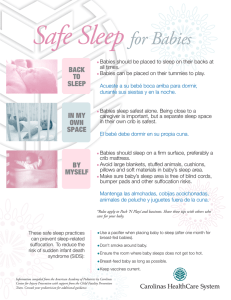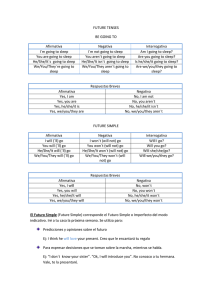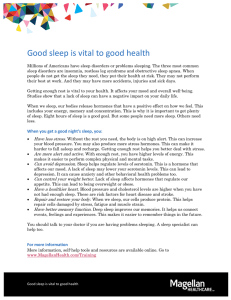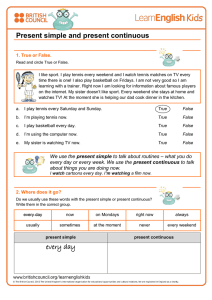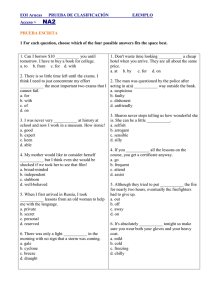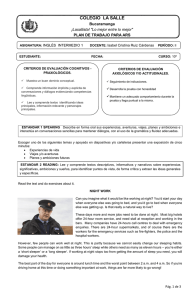Cost–Effectiveness and Degree of Satisfaction With Home Sleep
Anuncio
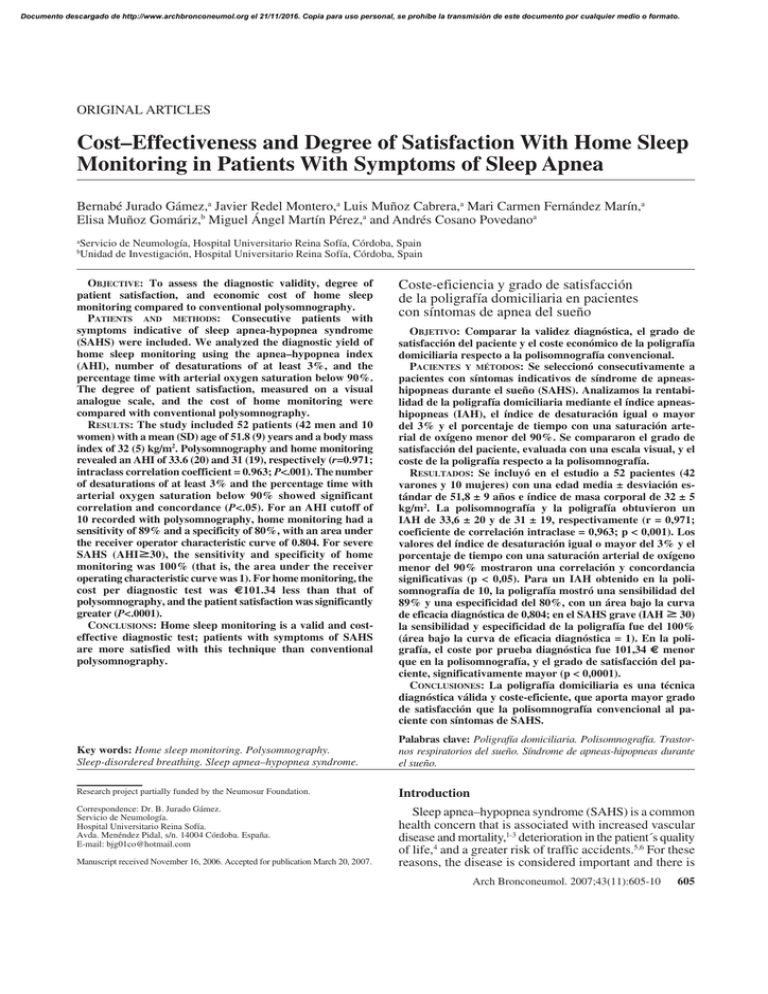
Documento descargado de http://www.archbronconeumol.org el 21/11/2016. Copia para uso personal, se prohíbe la transmisión de este documento por cualquier medio o formato. ORIGINAL ARTICLES Cost–Effectiveness and Degree of Satisfaction With Home Sleep Monitoring in Patients With Symptoms of Sleep Apnea Bernabé Jurado Gámez,a Javier Redel Montero,a Luis Muñoz Cabrera,a Mari Carmen Fernández Marín,a Elisa Muñoz Gomáriz,b Miguel Ángel Martín Pérez,a and Andrés Cosano Povedanoa a Servicio de Neumología, Hospital Universitario Reina Sofía, Córdoba, Spain Unidad de Investigación, Hospital Universitario Reina Sofía, Córdoba, Spain b OBJECTIVE: To assess the diagnostic validity, degree of patient satisfaction, and economic cost of home sleep monitoring compared to conventional polysomnography. PATIENTS AND METHODS: Consecutive patients with symptoms indicative of sleep apnea-hypopnea syndrome (SAHS) were included. We analyzed the diagnostic yield of home sleep monitoring using the apnea–hypopnea index (AHI), number of desaturations of at least 3%, and the percentage time with arterial oxygen saturation below 90%. The degree of patient satisfaction, measured on a visual analogue scale, and the cost of home monitoring were compared with conventional polysomnography. RESULTS: The study included 52 patients (42 men and 10 women) with a mean (SD) age of 51.8 (9) years and a body mass index of 32 (5) kg/m2. Polysomnography and home monitoring revealed an AHI of 33.6 (20) and 31 (19), respectively (r=0.971; intraclass correlation coefficient = 0.963; P<.001). The number of desaturations of at least 3% and the percentage time with arterial oxygen saturation below 90% showed significant correlation and concordance (P<.05). For an AHI cutoff of 10 recorded with polysomnography, home monitoring had a sensitivity of 89% and a specificity of 80%, with an area under the receiver operator characteristic curve of 0.804. For severe SAHS (AHIⱖ30), the sensitivity and specificity of home monitoring was 100% (that is, the area under the receiver operating characteristic curve was 1). For home monitoring, the cost per diagnostic test was €101.34 less than that of polysomnography, and the patient satisfaction was significantly greater (P<.0001). CONCLUSIONS: Home sleep monitoring is a valid and costeffective diagnostic test; patients with symptoms of SAHS are more satisfied with this technique than conventional polysomnography. Coste-eficiencia y grado de satisfacción de la poligrafía domiciliaria en pacientes con síntomas de apnea del sueño OBJETIVO: Comparar la validez diagnóstica, el grado de satisfacción del paciente y el coste económico de la poligrafía domiciliaria respecto a la polisomnografía convencional. PACIENTES Y MÉTODOS: Se seleccionó consecutivamente a pacientes con síntomas indicativos de síndrome de apneashipopneas durante el sueño (SAHS). Analizamos la rentabilidad de la poligrafía domiciliaria mediante el índice apneashipopneas (IAH), el índice de desaturación igual o mayor del 3% y el porcentaje de tiempo con una saturación arterial de oxígeno menor del 90%. Se compararon el grado de satisfacción del paciente, evaluada con una escala visual, y el coste de la poligrafía respecto a la polisomnografía. RESULTADOS: Se incluyó en el estudio a 52 pacientes (42 varones y 10 mujeres) con una edad media ± desviación estándar de 51,8 ± 9 años e índice de masa corporal de 32 ± 5 kg/m2. La polisomnografía y la poligrafía obtuvieron un IAH de 33,6 ± 20 y de 31 ± 19, respectivamente (r = 0,971; coeficiente de correlación intraclase = 0,963; p < 0,001). Los valores del índice de desaturación igual o mayor del 3% y el porcentaje de tiempo con una saturación arterial de oxígeno menor del 90% mostraron una correlación y concordancia significativas (p < 0,05). Para un IAH obtenido en la polisomnografía de 10, la poligrafía mostró una sensibilidad del 89% y una especificidad del 80%, con un área bajo la curva de eficacia diagnóstica de 0,804; en el SAHS grave (IAH ⱖ 30) la sensibilidad y especificidad de la poligrafía fue del 100% (área bajo la curva de eficacia diagnóstica = 1). En la poligrafía, el coste por prueba diagnóstica fue 101,34 € menor que en la polisomnografía, y el grado de satisfacción del paciente, significativamente mayor (p < 0,0001). CONCLUSIONES: La poligrafía domiciliaria es una técnica diagnóstica válida y coste-eficiente, que aporta mayor grado de satisfacción que la polisomnografía convencional al paciente con síntomas de SAHS. Key words: Home sleep monitoring. Polysomnography. Sleep-disordered breathing. Sleep apnea–hypopnea syndrome. Palabras clave: Poligrafía domiciliaria. Polisomnografía. Trastornos respiratorios del sueño. Síndrome de apneas-hipopneas durante el sueño. Research project partially funded by the Neumosur Foundation. Introduction Correspondence: Dr. B. Jurado Gámez. Servicio de Neumología. Hospital Universitario Reina Sofía. Avda. Menéndez Pidal, s/n. 14004 Córdoba. España. E-mail: [email protected] Sleep apnea–hypopnea syndrome (SAHS) is a common health concern that is associated with increased vascular disease and mortality,1-3 deterioration in the patient´s quality of life,4 and a greater risk of traffic accidents.5,6 For these reasons, the disease is considered important and there is Manuscript received November 16, 2006. Accepted for publication March 20, 2007. Arch Bronconeumol. 2007;43(11):605-10 605 Documento descargado de http://www.archbronconeumol.org el 21/11/2016. Copia para uso personal, se prohíbe la transmisión de este documento por cualquier medio o formato. JURADO GÁMEZ B ET AL. COST–EFFECTIVENESS AND DEGREE OF SATISFACTION WITH HOME SLEEP MONITORING IN PATIENTS WITH SYMPTOMS OF SLEEP APNEA a need for early diagnosis and treatment, particularly in view of the fact that effective treatment is available.7,8 The choice of diagnostic technique should be based on clinical suspicion and the diagnostic tools available, and the most cost-effective test should be the one used. Overnight polysomnography in a sleep laboratory is considered the gold standard for diagnosis of SAHS.8 However, given that this test is expensive and that the waiting list is unacceptably long, other diagnostic approaches have been sought. Of the alternative approaches, the most widely used is the study of respiratory variables during home sleep monitoring. This technique can be done in any health setting, although unsupervised studies in the patient´s home are uncommon.9,10 On the other hand, reducing the diagnostic costs and accounting for the preferences of the patient are also important goals that have not yet been studied in a sample of symptomatic patients. The aim of this study was to compare the diagnostic validity, patient satisfaction, and the cost of home sleep monitoring with those of overnight polysomnography in a sleep laboratory. Patients and Methods The study was carried out in the Sleep-Disordered Breathing Unit, which operates under the auspices of the Pneumology Department of Hospital Universitario Reina Sofía in Cordoba, Spain. The unit performs on average 600 conventional polysomnographic studies a year and has an outpatient clinic that can specifically assess sleep-disordered breathing. The patients were referred from primary health care or by specialists for assessment of sleep-disordered breathing. All patients who met the inclusion criteria gave their consent to participate after receiving information on the nature of the study. They underwent home sleep monitoring and a full conventional polysomnographic study in a random order using methods similar to the ones reported in a previous study.11 Both studies were performed within 2 weeks and were reviewed manually by the same physician (BJG). To ensure that the investigator was unaware of the result of the first test, the patients were identified by a 6-digit number and 3 letters. Study Population The patients eligible for inclusion were those who were consecutively referred to our clinic for assessment of sleepdisordered breathing. We included all patients with a high clinical suspicion of SAHS, defined as irregular daily snoring, observed apneas, unrefreshing sleep, and daytime sleepiness (Epworth score ≥14). The Epworth score was determined using a validated Spanish version of the test.12 All patients had to be resident in Cordoba, have an acceptable domestic living situation, be aged between 18 and 70 years, and collaborate sufficiently with the home sleep monitoring study. Patients with acute intercurrent disease, unstable ischemic heart disease, uncompensated heart failure, respiratory failure, or drug addiction including alcoholism were not included in the population. In this study, results of home monitoring were considered invalid if the oronasal airflow or pulse oximetry signal was lost during recording. Likewise, polysomnographic studies with a total sleep time of less than 180 minutes were considered invalid. The Ethics Committee of Hospital Universitario Reina Sofía in Cordoba reviewed and approved the study. 606 Arch Bronconeumol. 2007;43(11):605-10 Outcome Measures Home sleep monitoring. Several days before home sleep monitoring, the patients were reminded of the general recommendations for any sleep study. On the night of the test, a technician specialized in sleep studies called at the home of the patient and programmed the polygraph to start recording 15 minutes after the patient had gone to bed and to continue for 6 hours. The following day, the trace was collected and possible incidents during the night were recorded. The patient satisfaction was also recorded using a visual analogue scale in which 0 corresponded to the worst possible satisfaction and 10 to the best possible satisfaction. For the test, a bedside system (Compumedic Series-P Screener Compumedic Sleep Ltd, Abbotsford, Australia) was used. This system is compatible with the software of our polysomnographic device and records airflow signals with a thermistor and pressure sensor, chest and abdominal effort, arterial oxygen saturation signals (SaO2), heart rate, tracheal microphone recordings, body position, and electromyogram of the anterior tibial muscle. The same type of sensors were used for both home monitoring and polysomnography in an effort to ensure that the differences found were attributable only to the intrinsic characteristics of the test, that is, whether it was done in the laboratory or at home and with or without health professionals in attendance. The data were subsequently processed in the sleep laboratory. The criteria for apnea, hypopnea, and SaO2 analysis were the same as used for the polysomnographic study, except that with home sleep monitoring it was not possible to assess the presence of arousals to mark an event such as hypopnea and that the apnea–hypopnea index (AHI) was calculated with respect to the recorded period. Polysomnography. The polysomnographic study was done with a ProFusion-PSG2 (Compumedic Sleep Ltd, Abbotsford, Australia) polysomnograph with the same recording time as for home sleep monitoring (6 hours). Two electroencephalographic leads were monitored (C4/A1 and C3/A2), and an electrooculogram and an electromyogram of the submentonian and anterior tibia were recorded. The oronasal airflow was studied with a thermistor and pressure sensor. Likewise, sound was recorded with a tracheal microphone and the chest and abdominal effort was monitored as well as the electrocardiographic and SaO2 signals. All studies were analyzed automatically using the airflow signal from the pressure sensor as the main channel for analysis of respiratory events. These were then manually corrected using the recommendations of Rechtschaffen and Kales.13 Apnea was defined as lack of oronasal airflow during at least 10 seconds. Hypopnea was defined as a decrease in the oronasal airflow of more than 60% along with a decrease in SaO2 signal of at least 3% with or without an accompanying arousal. The following respiratory parameters were recorded: AHI, minimum SaO2 value during sleep, oxygen desaturation index equal or greater than 3% (ODI3), and percentage time with SaO2 below 90% (T90). ODI3 was defined as the number of oxygen desaturations of at least 3% per hour of sleep (polysomnography) or for the entire recorded period (home sleep monitoring). T90 was calculated for the entire sleep time (polysomnography) or the recorded period (home sleep monitoring). At the end of the polysomnographic study or home sleep monitoring, the patients´ satisfaction with the test was recorded using a visual analogue scale. In the study population, SAHS was diagnosed when the AHI was at least 10 in the polysomnographic study.14 Cost Analysis The cost analysis did not take into account acquiring the devices, disposable material, or maintenance. Documento descargado de http://www.archbronconeumol.org el 21/11/2016. Copia para uso personal, se prohíbe la transmisión de este documento por cualquier medio o formato. JURADO GÁMEZ B ET AL. COST–EFFECTIVENESS AND DEGREE OF SATISFACTION WITH HOME SLEEP MONITORING IN PATIENTS WITH SYMPTOMS OF SLEEP APNEA Polysomnography (AHI) 100 70 100 60 80 80 50 60 60 40 30 40 40 20 20 20 10 0 0 0 20 40 60 80 0 0 10 Home Sleep Monitoring (AHI) 20 30 40 50 0 20 T90 40 60 80 100 ODI3 Figure 1. Correlation between variables that assess sleep-disordered breathing, determined with the home monitoring device and polysomnography. AHI indicates apnea-hypopnea index; ODI3, number of decreases of >3% in arterial oxygen saturation; T90, sleep duration (polysomnography) or recorded time (home sleep monitoring) with arterial oxygen saturation <90%. In our sleep-disordered breathing unit, 2 technicians specialized in sleep studies do 2 polysomnographic studies per day on alternate nights. The number of polysomnographic studies carried out in 2005 was 568. The calculation of the cost of the test was performed by summing the annual salary of the 2 technicians and dividing the result by the mean number of polysomnographs recorded in a year. To do this, we added the cost of a stay in a hospital ward, calculated to be €60, and the cost of the 90 minutes required for manual analysis of the test and for issuing the report. The costs of home sleep monitoring included the travel costs to the patient´s home to put the sensors in place, plus the cost of another journey on the following day to collect the equipment and record the observed incidents. The total estimated time was 2 hours, to which the cost of manual analysis and writing the report, estimated to be 45 minutes, was added. Once the data had been recorded, the cost of an additional test after an inconclusive result was added. Statistical Analysis The data for each test are described using means, SD, and minimum and maximum values for continuous variables, and frequencies and percentages for categoric variables. The quantitative data were compared with the Student t test for paired samples. Qualitative data were compared with the χ2 test. The diagnostic validity of home sleep monitoring was assessed by constructing receiver operating characteristic (ROC) curves and measuring the area under the curve for AHI obtained in the polysomnograph equal to or greater than 10 or 30; in addition, for these values, the best cutoff for the home sleep monitoring was obtained. The extent of agreement and correlation between AHI, ODI3, and T90 measured with polysomnography and home sleep monitoring was calculated using the intraclass correlation coefficient and the Pearson correlation coefficient. Patient satisfaction was analyzed with the Wilcoxon test for paired data. The data were analyzed with the Statistical Package for Social Sciences (SPSS) for Windows (SPSS, Chicago, Illinois, USA). Results Of the 55 patients who were invited to participate in the study, only 3 (5.4%) refused, the remaining 52 (94.5%) agreed. The study included 42 men and 10 women with a mean (SD) age of 51.8 (9) years, a body mass index of 32 (5) kg/m2, and a score on the Epworth test of 15.9 (1). Five home sleep monitoring tests (9.6%) were repeated due to a defective signal. One polysomnography test (2%) was repeated because the sleep time was less than 180 minutes. The assessment of respiratory events and their repercussion on SaO2 (ODI3 and T90) measured using the 2 techniques is shown in Table 1. The correlation between the 2 tests is shown in Figure 1. Conventional polysomnography diagnosed 47 of the 52 patients studied for suspicion of SAHS whereas home sleep monitoring diagnosed 42. Of the 5 patients not diagnosed with SAHS according to the results of polysomnography, 4 were not diagnosed with home sleep monitoring either; therefore, diagnosis coincided in 88.4% of the cases (46/52). Home sleep monitoring gave a false positive in a patient with an AHI of 13, when polysomnography yielded a value of 8. An analysis of the results from the 6 home sleep monitoring tests in TABLE 1 Strength of Correlation and Concordance Between Home Sleep Monitoring and Polysomnography in a Sleep Laboratory for the Main Respiratory Variables* Polysomnography Home Sleep Monitoring Pearson Coefficient CCI (95% CI) AHI 33.6 (20) 31 (19) 0.971† ODI3 24.5 (19.55) 28.7 (23.17) 0.893† 9 (12) 10.1 (11.6) 0.709† 0.963 (0.916-0.982) 0.936 (0.888-0.963) 0.706 (0.539-0.81) T90 *Values expressed as mean (SD). ICC indicates intraclass correlation coefficient; AHI, number of apneic or hypopneic events per sleep time (polysomnography) or recorded time (home sleep monitoring); CI, confidence interval; ODI3, number of decreases >3% in arterial oxygen saturation; T90, sleep duration (polysomnography) or recorded time (home sleep monitoring) with arterial oxygen saturation <90%. †Statistically significant for a P value <.05. Arch Bronconeumol. 2007;43(11):605-10 607 Documento descargado de http://www.archbronconeumol.org el 21/11/2016. Copia para uso personal, se prohíbe la transmisión de este documento por cualquier medio o formato. JURADO GÁMEZ B ET AL. COST–EFFECTIVENESS AND DEGREE OF SATISFACTION WITH HOME SLEEP MONITORING IN PATIENTS WITH SYMPTOMS OF SLEEP APNEA Discussion 10 9 8 7 6 5 P=.0001 4 3 2 1 0 Polysomnography Home Sleep Monitoring Figure 2. Comparison of patient satisfaction with conventional polysomnography and home sleep monitoring. disagreement showed that the mean AHI obtained with polysomnography was relatively low (AHI, 14) and 3 of these patients (50%) suffered psychogenic disorders such as anxiety and depression. For an AHI greater than or equal to 10 in the polysomnographic study, AHI measured during home sleep monitoring had an area under the ROC curve of 0.804, with an optimum cutoff value of 5.6. In contrast, for an AHI greater than or equal to 30 in the polysomnographic study, the area under the ROC curve for AHI measured in the home sleep monitoring was 1, with an optimum cutoff value of 26.4. The cost analysis is shown in Table 2. The final cost of polysomnography was €250 whereas home sleep monitoring cost €140, that is, there was a saving of €104.34 per patient and diagnostic test with home sleep monitoring. Statistically significant differences were observed between the 2 tests in the degree of patient satisfaction measured on a visual analogue scale (Figure 2)—the median score with polysomnography was 7 compared to 9 with home sleep monitoring (P<.0001). TABLE 2 Comparison of Costs Derived From Diagnostic Studies Done for Home Sleep Monitoring and Polysomnography Variables Home Sleep Monitoring Cost of the test €140 Cost of the tests 52×140=€7280 Additional cost 5×140=€700 for test repetitions Total cost of the tests €7980 Cost per diagnostic test* €153.46 Polysomnography €250 52×250=€13 000 1×250=€250 *Mean cost of the sum of all tests done to arrive at a diagnosis. 608 Arch Bronconeumol. 2007;43(11):605-10 €13 250 €254.80 In a selected sample of patients with a high clinical suspicion of SAHS, home sleep monitoring showed high diagnostic validity and proved a cost-effective technique. In addition, patients were more satisfied with the technique than with conventional polysomnography. In highly symptomatic patients with SAHS and a high AHI, polysomnography could be avoided in 88.4% of the cases. No false negatives were observed among patients diagnosed with severe SAHS (AHI≥30). Currently, SAHS is an important health problem, not only because it is highly prevalent—2% to 4% of middleaged adults are estimated to be affected15,16—but also because it is associated with increased cardiovascular risk.1-3 Furthermore, compared to the general population, health resource usage is 2 to 3 times greater when delays in diagnosis and treatment of patients with SAHS occur.17,18 These figures are all the more important bearing in mind that an effective treatment is available in the form of continuous positive airway pressure.7,8 Currently, sleep studies are generally done in hospitals19 and polysomnography is the gold standard diagnostic test for SAHS.8 The main drawbacks are the long waiting lists and the lack of availability in certain health care settings. In this context, home sleep monitoring is a complementary technique to polysomnography and doing the test in the patient´s home seems a reasonable goal.20-22 In our study, the variability in respiratory events in both tests was limited. Although small, this variability could be due to disagreement between the total sleep time and the time recorded during home sleep monitoring.23,24 To try to avoid this problem, the study time was reduced to 6 hours to ensure that the recorded time corresponded as closely as possible to the total sleep time. It is likely that this improved the results of home sleep monitoring. One of the problems attributable to home sleep monitoring is the lack of information on the quality of sleep, which can be different in the sleep laboratory and at home. However, in a patient with high probability of SAHS, poor sleep quality can be justified, initially, by respiratory disorders. Likewise, the fact that tests were done on different nights is unlikely to have a great influence on the study findings because the variability in respiratory events from one night to the next is limited in patients with moderate or severe SAHS.25 A potential problem with home sleep monitoring is the lack of supervision, which could increase the rate of invalid recordings. In our study, this problem was insignificant; the percentage of tests not valid for diagnosis (9.6%) was similar to that reported in other studies, where the percentage varied between 10% and 20%.9,10,22 This low percentage of home sleep monitoring recordings that were invalid for technical reasons suggests that the test is feasible even if performed at home. As might be expected in a selected sample, the prevalence of SAHS was high (90%). This is unsurprising given that the presenting complaint was sleep-disordered breathing.21,26 An interesting finding is the high diagnostic yield of home sleep monitoring; in 88.4% of the cases (46/52), diagnosis with home sleep monitoring was identical Documento descargado de http://www.archbronconeumol.org el 21/11/2016. Copia para uso personal, se prohíbe la transmisión de este documento por cualquier medio o formato. JURADO GÁMEZ B ET AL. COST–EFFECTIVENESS AND DEGREE OF SATISFACTION WITH HOME SLEEP MONITORING IN PATIENTS WITH SYMPTOMS OF SLEEP APNEA to that of polysomnography, which would therefore not need to be performed. In our study, 5 false negatives were obtained with home sleep monitoring although polysomnographic findings classified these cases as mild SAHS (mean AHI, 14). Similar observations have already been made with home sleep monitoring in a study that reported higher diagnostic yield at high values of AHI.27 In contrast, only one false positive was obtained (AHI of 13 in home sleep monitoring and 8 in polysomnography) with the current diagnostic criterion for true SAHS.8 The choice of test to investigate sleep-disordered breathing should depend on the degree of clinical suspicion. To increase the diagnostic yield, it is reasonable to select symptomatic patients for home sleep monitoring. Such patients would have a high probability of severe SAHS. Our results suggest that overnight polysomnography is not always necessary for diagnosis of SAHS; this test can be reserved for when diagnosis with home sleep monitoring is inconclusive, for assessment of the increased upper airway resistance syndrome, for studying nonrespiratory sleep disorders, and, probably, for patients with psychological illnesses. In our study, 3 of the 6 cases in which home sleep monitoring did not agree with polysomnography belonged to this latter group. We should emphasize that home sleep monitoring also helped to correctly determine the severity of SAHS. For an AHI of 30 or more in polysomnography, the area under the ROC curve for home sleep monitoring was 1 (sensitivity and specificity of 100%), supporting the high diagnostic accuracy of the test. These results touch on 2 key points, namely, diagnostic validity and influence of home sleep monitoring in therapeutic decisions, as continuous positive airway pressure is recommended for an AHI of 30 or more8 particularly if, as was the case in our study, patients suffer from daytime sleepiness.28 In addition to AHI, the repercussion of respiratory events on SaO2 should not be forgotten when assessing the severity of SAHS. Episodes of nighttime hypoxemia have been associated with increased morbidity and mortality1-3 and, recently, with increased oxidative stress and atherogenesis.29,30 According to our data, home sleep monitoring correctly measures intermittent decreases in SaO2, defined by ODI3, and sustained periods of hypoxemia, defined by T90. To attain these results, it is important to perform a manual analysis that correctly excludes recorded periods that contain artifacts in the oronasal airflow or SaO2 signal. The cost analysis applies only to our particular service in that it will vary according to where and how the diagnostic tests are performed.10,22 Efficiency is closely linked to diagnostic yield; in our series there were few invalid studies. This result could be explained by the journey of the technician to the patient´s home to place the sensors and thus ensure a good quality study. As discussed previously, the cost analysis did not include purchase of devices or maintenance costs given that such figures are hard to calculate for devices that last on average several years. Likewise, disposable material was not taken into account, although costs are similar for both techniques in our experience. In home monitoring, the sensors probably deteriorate more quickly, although the neurophysiological sensors are more fragile. In view of the above, our study shows that home sleep monitoring is a cost-effective technique that can avoid the need for polysomnographic studies and save €101.34 per diagnostic test. A significant finding is the greater patient satisfaction when the test was done at home. However, other studies found that patients prefer polysomnography in a sleep laboratory.10,21 That said, we should remember that polysomnography done at home is technically more complex, and this might have influenced the patient´s preference. In short, although overnight polysomnography is the gold standard for studying sleep-disordered breathing, our results do not support the need for it to be done routinely for diagnosis of severe SAHS. It is useful to establish a diagnostic strategy guided by the patient´s symptoms and to assess the probability of having SAHS. Home sleep monitoring is a valid and cost-effective diagnostic test in highly symptomatic patients and scores more highly on patient satisfaction than overnight polysomnography in a sleep laboratory. REFERENCES 1. Parra O, Arboix A, Bechich S, García-Eroles L, Monserrat JM, López JA, et al. Time course of sleep-related breathing disorderes in firstever stroke or transient ischemic attack. Am J Respir Crit Care Med. 2000;161:375-80. 2. Marín JM, Carrizo SJ, Vicente F, Agustí A. Long-term cardiovascular outcomes in men with obstructive sleep apnoea-hypopnoea with or without treatment with continuous positive airway pressure: an observational study. Lancet. 2005;365:1046-53. 3. Peker Y, Carlson J, Hedner J. Increased incidence of coronary artery disease in sleep apnoea: a long-term follow-up. Eur Respir J. 2006;28:596-602. 4. Baldwin CM, Griffith KA, Nieto FJ, O´Connor GT, Walsleben JA, Redline S. The association of sleep-disordered breathing and sleep symptoms with quality of life in the Sleep Heart Health Study. Sleep. 2001;24:96-105. 5. Terán-Santos J, Jiménez-Gómez A, Cordero-Guevara J, et al. The association between sleep apnea and the risk of traffic accidents. N Engl J Med. 1999;340:847-51. 6. Barbé F, Pericás J, Muñoz A, Findley L, Antó JM, Agustí AGN. Automobile accident in patients with sleep apnea syndrome. Am J Respir Crit Care Med. 1998;158:18-22. 7. White J, Wright J. Continuous positive airways pressure for obstructive sleep apnoea. Cochrane Database Syst Rev. 2002;(2): CD001106. 8. Grupo Español de Sueño. Consenso nacional sobre el síndrome de apneas-hipopneas del sueño. Arch Bronconeumol. 2005;41 Supl 4:1110. 9. Parra O, García Esclasan N, Monserrat JM, et al. Should patients with sleep apnoea/hypopnoea syndrome be diagnosed and managed on the basis of home sleep studies? Eur Respir J. 1997;10:1720-4. 10. Portier F, Portmann A, Czernichow P, et al. Evaluation of home vs laboratory polysomnography in the diagnosis of sleep apnea syndrome. Am J Respir Crit Care Med. 2000;162:814-8. 11. Jurado Gámez B, Rubio Sánchez JM, Muñoz Cabrera L, et al. Poligrafía domiciliaria. ¿Es una técnica válida para el diagnóstico del síndrome de apneas obstructivas del sueño? Neumosur. 2005;17:184-9. 12. Chiner E, Arriero J, Signes-Costa J, Marco J, Fuentes I. Validación de la versión española del test de somnolencia Epworth en pacientes con síndrome de apnea de sueño. Arch Bronconeumol. 1999;35: 422-7. 13. Rechtschaffen A, Kales A. A manual of standardized terminology, techniques and scoring system for sleep stages of human subjects. Washington DC: Government Printing Office; 1968. NIH publication no. 204. Arch Bronconeumol. 2007;43(11):605-10 609 Documento descargado de http://www.archbronconeumol.org el 21/11/2016. Copia para uso personal, se prohíbe la transmisión de este documento por cualquier medio o formato. JURADO GÁMEZ B ET AL. COST–EFFECTIVENESS AND DEGREE OF SATISFACTION WITH HOME SLEEP MONITORING IN PATIENTS WITH SYMPTOMS OF SLEEP APNEA 14. Barbé F, Amilibia J, Capote F, Durán J, Mangado NG, Jiménez A, et al. Normativas SEPAR: diagnóstico del síndrome de apneas obstructivas durante el sueño: informe de consenso del área de insuficiencia respiratoria y trastornos del sueño. Arch Bronconeumol. 1995;31:460-2. 15. Young T, Palta M, Dempsey J, Skatrud J, Weber S, Badr S. The occurrence of sleep disorders breathing among middle aged adults. N Engl J Med. 1993;328:1230-6. 16. Durán J, Esnaola S, Rubio R, Iztueta A. Obstructive sleep apneahypopnea and related clinical features in a population-based sample of subjects aged 30 to 70 yr. Am J Respir Crit Care Med. 2001;163: 685-9. 17. Kryger MH, Ross L, Delaive K, Walld R, Horrocks J. Utilization of health care services in patients with severe obstructive sleep apnea. Sleep. 1996;19:S111-S6. 18. Ronald J, Delaive K, Roos L, Manfreda J, Bahammam A, Kryger MH. Health care utilization in the 10 years prior to diagnosis in obstructive sleep apnea patients. Sleep. 1999;2:225-9. 19. Durán-Cantollá J, Mar J, de la Torre Muñecas G, Rubio Aramendi R, Guerra L. El síndrome de apneas-hipopneas durante el sueño en España. Disponibilidad de recursos para su diagnóstico y tratamiento en los hospitales del Estado español. Arch Bronconeumol. 2004;40:259-67. 20. García Díaz EM, Capote Gil F, Cano Gómez S, Sánchez Armengol A, Carmona Bernal C, Soto Campos JG. Poligrafía respiratoria en el diagnóstico del síndrome de apneas obstructivas durante el sueño. Arch Bronconeumol. 1997;33:69-73. 21. Martínez García MA, Soler Cataluña JJ, Román Sánchez P. Uso secuencial de la pulsioximetría nocturna y la poligrafía respiratoria (AutoSet®) para el diagnóstico del síndrome de apneas-hipopneas durante el sueño en pacientes con alta sospecha clínica. Arch Bronconeumol. 2003;39:74-80. 22. Golpe R, Jiménez A, Carpizo R. Home sleep studies in the assessment of sleep apnea/hypopnea syndrome. Chest. 2002;122:1156-61. 610 Arch Bronconeumol. 2007;43(11):605-10 23. Redline S, Tosteson T, Boucher MA, Millman RP. Measurement of sleep-related breathing disturbances in epidemiological studies. Assessment of the validity and reproducibility of a portable monitoring device. Chest. 1991;100:1281-6. 24. Meyer TJ, Eveloff SE, Kline LR, Millman RP. One negative polysomnogram does not exclude obstructive sleep apnea. Chest. 1993;103:756-60. 25. Chediak AD, Acevedo-Crespo JC, Seiden DJ, et al. Nightly variability in the index of sleep-disordered breathing in men being evaluated for impotence with consecutive night polysomnograms. Sleep. 1996;19:589-92. 26. Mayer P, Meurice JC, Philip-Joet F, Cornette A, Rakotonanahary D, Meslier N, et al. Simultaneous laboratory-based comparison of ResMed Autoset with polysomnography in the diagnosis of sleep apnea/hypopnea syndrome. Eur Respir J. 1998;12:770-5. 27. Candela A, Hernández L, Asensio S, Sánchez-Payá J, Vila J, Benito N, et al. Validación de un equipo de poligrafía respiratoria en el diagnóstico del síndrome de apneas durante el sueño. Arch Bronconeumol. 2005;41:71-7. 28. Barbé F, Mayorales LR, Durán J, et al. Treatment with continuous positive airway pressure is not effective in patients with sleep apnea but no daytime sleepiness Ann Intern Med. 2001;134:101523. 29. Barceló A, Barbé F, de la Peña M, Vila M, Pérez G, Piérolas J, et al. Antioxidant status in patients with sleep apnoea and impact of continuous positive airway pressure treatment. Eur Respir J. 2006;27:756-60. 30. Hayashi M, Fujimoto K, Urushibata K, Takamizawa A, Kinoshita O, Kubo K. Hypoxia-sensitive molecules may modulate the develoment of atherosclerosis in sleep apnoea syndrome. Respirology. 2006;11:24-31. 31. Fry JM, di Phillipo MA, Curran K, et al. Full polysomnography in the home. Sleep. 1998;21:635-42.
